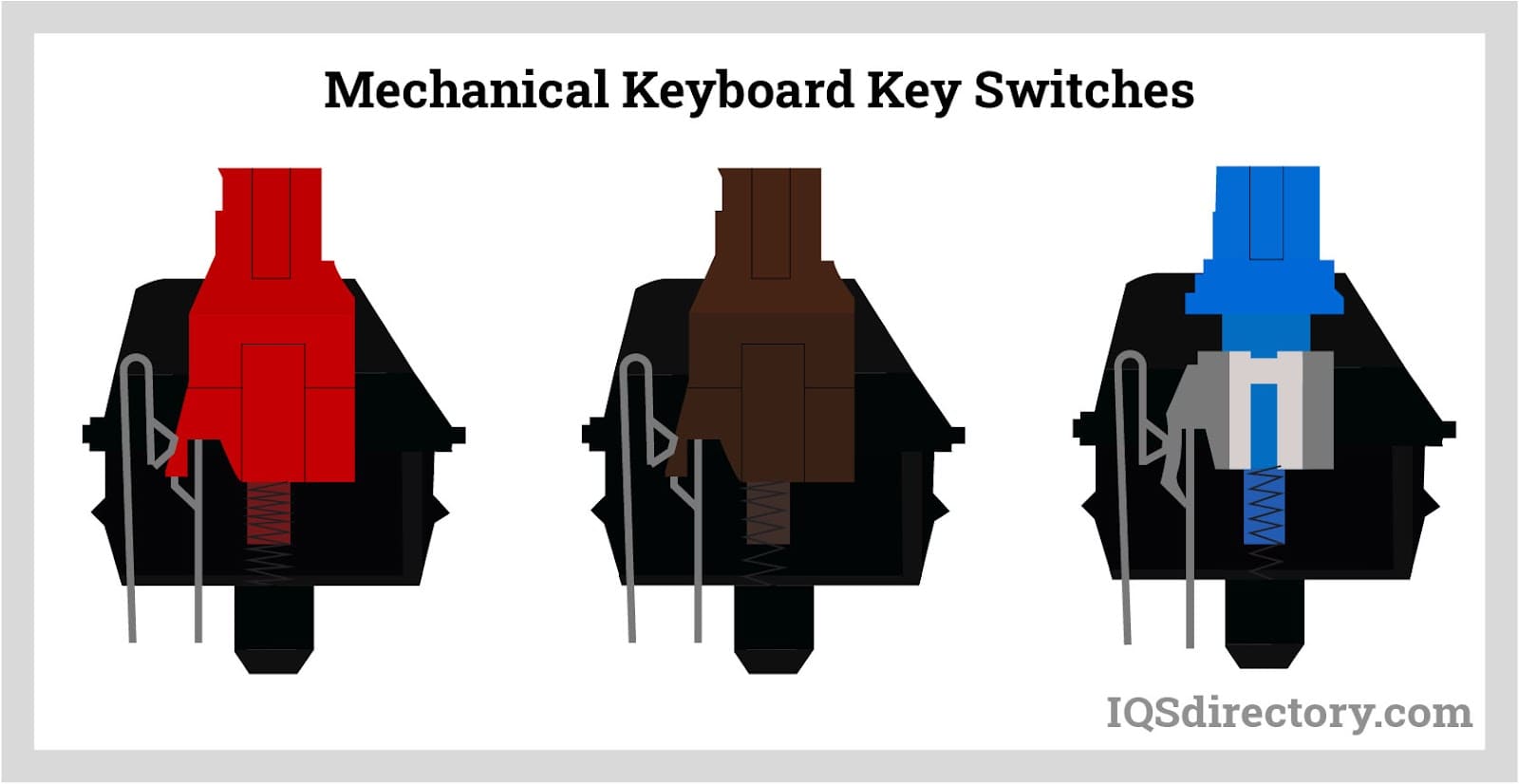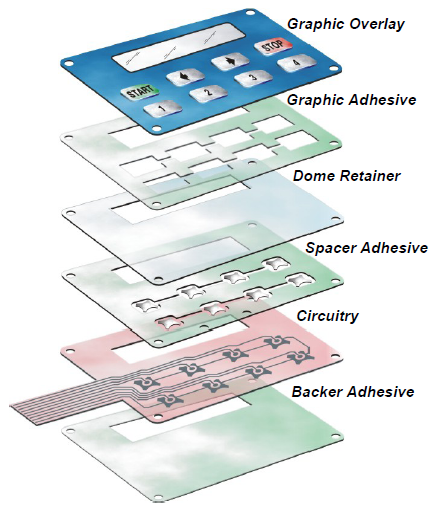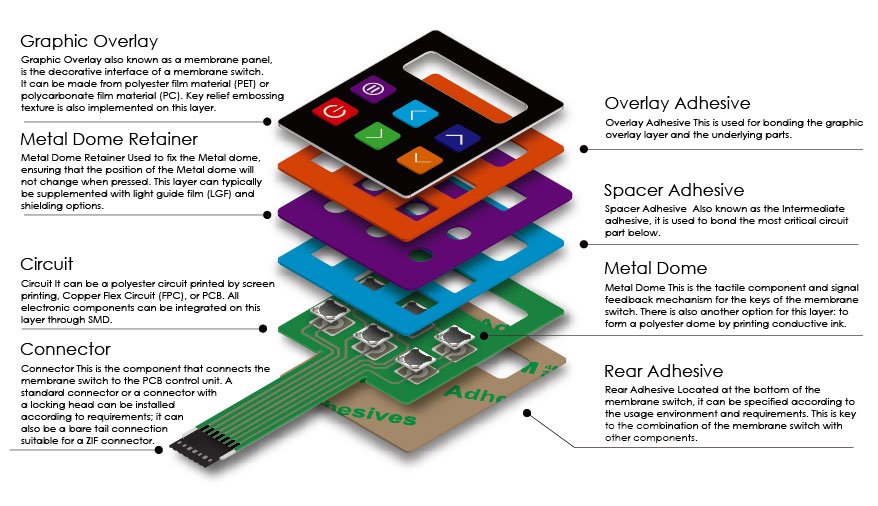The Manufacturing Refine Behind Membrane Change: What You Need to Know
The production procedure behind membrane switches over combines careful layout, material option, and quality assurance. It begins with comprehending the details of membrane button style and proceeds via different phases, including product choices and printing methods. Each phase plays a crucial role in making certain performance and longevity. The intricacies of layer building and the strenuous screening standards might expose insights that are not instantly evident. What exists beyond these foundational aspects?
Recognizing Membrane Switch Style
Although membrane layer buttons might appear easy in the beginning look, their layout entails intricate considerations that ensure performance and longevity. The layout procedure starts with a detailed understanding of individual demands, including the interface's designated application and environmental factors. Functional designs is a crucial aspect, as the design should help with ease of use while ensuring that responsive responses fulfills individual expectations.Moreover, the layering of elements, such as graphic overlays, adhesive layers, and conductive traces, have to be specifically crafted. membrane switch. This layered configuration not only affects the button's responsiveness however also influences its long life. Interest is offered to the sealing strategies utilized to safeguard against dampness and dust, which could endanger efficiency. Additionally, design factors to consider include aesthetic appeals, where color systems and visual clarity boost individual experience. Ultimately, the layout of membrane switches equilibriums functionality, customer experience, and toughness, guaranteeing that they meet the needs of various applications properly
Materials Made Use Of in Membrane Switch Over Manufacturing
When picking materials for membrane layer switch production, it is important to contemplate both efficiency and resilience. The key materials consist of polyester and polycarbonate movies, which offer adaptability and stamina. These movies are commonly coated with glue to assure correct bonding to substratums. Conductive inks, usually made up of silver or carbon, are vital for creating electrical links within the switch, enabling for reliable operation.Additionally, a protective layer, such as a tough coat, is often used to boost scratch resistance and durability. The selection of backing material, such as acrylic or foam, can significantly influence the button's tactile feel and general customer experience. Various environmental aspects, consisting of temperature level and moisture, ought to direct material choice to ensure peak efficiency in details applications. Ultimately, the right combination of materials contributes to the membrane switch's performance and life expectancy, making notified options crucial for suppliers.
The Printing Refine: Creating Video and Text
The printing procedure in membrane layer button production plays a substantial duty in generating high-grade graphics and message. Numerous visuals style methods are utilized to guarantee visual appeal and functionality, while mindful ink option approaches are necessary for toughness and efficiency. Comprehending these aspects is fundamental for achieving ideal outcomes in membrane switch design.
Graphic Design Techniques
Graphic layout methods play a vital role in the printing procedure of membrane buttons, as they define how graphics and message will ultimately show up on the final item. Efficient graphic style involves the critical use of designs, typefaces, and colors to boost readability and aesthetic charm. Designers often utilize vector graphics for scalability, making sure that images stay sharp at numerous sizes. In addition, attention to comparison and placement is important, as it affects user interaction and visual quality. The consolidation of branding components, such as logos, need to be taken care of with care to preserve brand name integrity. Generally, thoughtful visuals layout techniques contribute substantially to the functionality and appearance of membrane layer buttons, impacting individual experience and item efficiency.
Ink Option Methods
Selecting the proper ink is crucial for achieving the preferred visual high quality and longevity in membrane switch production. Different ink kinds are made use of, consisting of solvent-based, water-based, and UV-curable inks. Each type uses distinct features, such as resistance, adhesion, and flexibility to environmental elements. Solvent-based inks are commonly preferred for their longevity and vivid shades, while water-based inks are extra eco-friendly yet might have restrictions in bond. UV-curable inks offer rapid curing and durable efficiency. In addition, color matching methods guarantee that the selected inks straighten with layout specs. Eventually, the choice of ink must take into consideration variables such as application technique, substrate compatibility, and end-use requirements to attain premium cause membrane button graphics and message.
Layer Building and Assembly

Material Choice Process
A cautious choice of products is necessary in the production procedure of membrane layer buttons, as it straight affects capability and sturdiness. The primary materials used include polyester, polycarbonate, and various conductive inks. Polyester is frequently favored for its outstanding resistance to chemicals and abrasion, making it appropriate for severe atmospheres. Polycarbonate, on the other hand, provides superior clarity and impact resistance, which is beneficial for applications requiring presence and effectiveness. Conductive inks, commonly made up of silver or carbon, are crucial for producing reputable electrical paths. In addition, the option of adhesive materials influences the overall integrity of the switch - membrane switch. Assessing variables such as environmental direct exposure, tactile feedback, and aesthetic needs guides manufacturers in picking the most effective materials for their specific applications
Layer Adhesion Methods
Sticking layers in membrane button construction is a crucial procedure that assures functionality and durability. Various attachment techniques are used to secure excellent bonding between layers, which commonly consist of using adhesives, heat, and pressure. Pressure-sensitive adhesives (PSAs) are typically utilized for their ease of application and immediate bonding abilities. Additionally, thermal bonding methods can be used, where heat is used to activate adhesive buildings, protecting a strong bond. The choice of attachment technique greatly depends on the materials entailed and the particular application requirements of the membrane switch. Appropriate positioning and consistent application of adhesives are necessary to prevent defects, safeguarding the switch operates effectively throughout its designated lifespan.
Top Quality Control Steps
Guaranteeing quality assurance during the layer building and assembly of membrane switches is crucial for preserving efficiency and reliability. This process generally involves a number of essential actions, consisting of complete inspections at each stage of production. Makers utilize sophisticated screening techniques, such as peel examinations and attachment assessments, to confirm the integrity of layer bonds. Furthermore, aesthetic inspections are performed to recognize any kind of issues in printing or product variances. Ecological problems, such as temperature level and moisture, are thoroughly checked to assure optimal curing and adhesion. Routine calibration of tools aids maintain accurate production criteria. By applying these quality assurance measures, manufacturers can substantially decrease the risk of item failing, assuring that the final membrane switches over fulfill the called for requirements and customer assumptions.
Evaluating and Top Quality Control Measures

Advancements in Membrane Switch Modern Technology
As improvements in innovation proceed to progress, membrane buttons are taking advantage of innovative growths that enhance their capability and individual experience. One notable technology is the combination of capacitive touch technology, which permits for more receptive and intuitive interface. This shift not just improves appearances however also minimizes mechanical wear and tear, prolonging the life-span of the switches.Additionally, developments in visuals overlay materials have actually led to enhanced longevity and resistance to environmental aspects such as moisture and UV light. These products currently provide improved quality and brightness, additional boosting the visual appeal.Furthermore, the consolidation of clever technology is transforming membrane switches over into interactive control panels, allowing connection with IoT devices. This connectivity promotes a smooth customer experience, paving the method for applications in different sectors, from medical care to consumer electronics. Collectively, these advancements placement membrane switches as vital elements in modern-day tool design.
Frequently Asked Questions
How much time Does the Membrane Layer Switch Over Production Refine Take?
The period of the membrane switch manufacturing process can vary considerably. Elements such as intricacy, products made use of, and manufacturing quantity impact timelines, with regular manufacturing varying from a couple of days to numerous weeks for conclusion.
What Are the Usual Applications for Membrane Switches?
Membrane switches are commonly utilized in various industries, consisting of auto controls, house devices, clinical gadgets, and consumer electronic devices (membrane switch). Their flexibility and longevity make them excellent for applications calling for straightforward user interfaces and reputable performance in diverse environments
Can Membrane Layer Changes Be Personalized for Certain Requirements?

What Is the Life-span of a Regular Membrane Switch?
The life expectancy of a normal membrane layer button differs, yet usually, it varies from 1 to 5 million cycles. Factors such as usage, environment, and material quality significantly influence sturdiness and general efficiency gradually.

Are Membrane Layer Switches Over Eco-friendly?
The environmental friendliness of membrane switches over varies. Some products made use of might not be recyclable, while others can be green. The find general effect depends upon producing techniques and products, demanding cautious consideration throughout option and disposal. The manufacturing process behind membrane layer changes combines careful design, product choice, and quality control. It starts with comprehending the complexities of membrane button design and proceeds with various phases, including product options and printing techniques. When choosing materials for membrane layer switch manufacturing, it is important to consider both performance websites and longevity. A mindful selection of products is important in the manufacturing procedure of membrane switches, as it straight influences capability and sturdiness. The selection of attachment approach mainly depends on the materials included and the certain application needs of the membrane button.